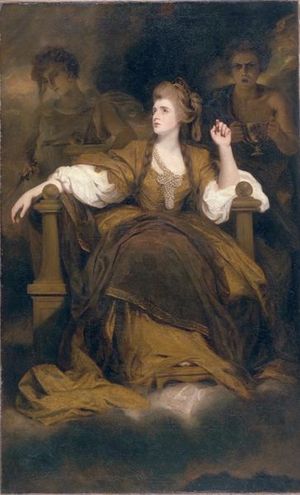Sarah Siddons
Sarah Siddons (July 5, 1755 – June 8, 1831) was a British actress, the best-known tragedienne of the 18th century. She was the elder sister of John Philip Kemble, Charles Kemble, Stephen Kemble, Ann Hatton and Elizabeth Whitlock. She was most famous for her portrayal of the Shakespearean character : Lady Macbeth, a character she made her own.
Biography
- Youth
She was born Sarah Kemble in Brecon, Brecknockshire, Wales, the eldest daughter of Roger Kemble, an actor-manager whose travelling company included most members of his family, and Sarah "Sally" Ward.
Acting was only just becoming a respectable profession for a woman and initially her parents disapproved of her choice of profession.
- Career
In 1774, Siddons won her first success as Belvidera in Thomas Otway's Venice Preserved. This brought her to the attention of David Garrick, who sent his deputy to see her as Calista in Thomas Rowe's Fair Penitent, the result being that she was engaged to appear at Drury Lane. Owing to inexperience as well as other circumstances, her first appearances as Portia and in other parts were not well received and she received a note from the manager of Drury Lane stating that her services would not be required. She was, in her own words :
- “ banished from Drury Lane as a worthless candidate for fame and fortune "
In 1777, she went on "the circuit" in the provinces. For the next six years she worked in provincial companies (in particular York and Bath), gradually building up a reputation, and her next Drury Lane appearance, on 10 October 1782, could not have been more different. She was an immediate sensation playing the title role in Garrick's adaptation of a play by Thomas Southerne, Isabella, or, The Fatal Marriage.
Her most famous role was that of Lady Macbeth, it was the grandeur of her emotions as she expressed Lady Macbeth's murderous passions that held her audiences spellbound. In Lady Macbeth she found the highest and best scope for her acting abilities. She was tall and had a striking figure, brilliant beauty, powerfully expressive eyes, and solemn dignity of demeanour which enabled her to claim the character as her own.
After Lady Macbeth she played Desdemona, Rosalind, Ophelia and Volumnia, all with great success; but it was in Queen Catherine that she discovered a part almost as well adapted to her acting powers as that of Lady Macbeth.
It was the beginning of twenty years in which she was the undisputed queen of Drury Lane. Her celebrity status has been called "mythical" and "monumental," and by "the mid-1780s Siddons was established as a cultural icon." She mixed with the literary and social elites of London society, and her acquaintances included Samuel Johnson, Edmund Burke, Hester Thrale Piozzi, and William Windham.
In 1802 she left Drury Lane and subsequently appeared from time to time on the stage of the rival establishment, Covent Garden. It was there, on 29 June 1812, that she gave perhaps the most extraordinary farewell performance in theatre history. She was playing her most famous role, Lady Macbeth, and the audience refused to allow the play to continue after the end of the sleepwalking scene. Eventually, after tumultuous applause from the pit, the curtain reopened and Siddons was discovered sitting in her own clothes and character - whereupon she made an emotional farewell speech to the audience lasting eight minutes.
Mrs Siddons formally retired from the stage in 1812, but occasionally appeared on special occasions. Her last appearance was on the 9th of June 1819 as Lady Randolph in John Home's Douglas.
- Personal life
In 1773, at the age of 18, she married William Siddons, an actor. Her family life was less fortunate; she gave birth to seven children but outlived five of them, and her marriage to William Siddons became strained and ended in an informal separation.
- Death
Sarah Siddons died in 1831 in London and was interred there in Saint Mary's Cemetery at Paddington Green.
See also [ Sarah Siddons Award ]
External links
http://www.sarahsiddonssociety.org/
- More information is available at [ Wikipedia:Sarah_Siddons ]
Chat rooms • What links here • Copyright info • Contact information • Category:Root
